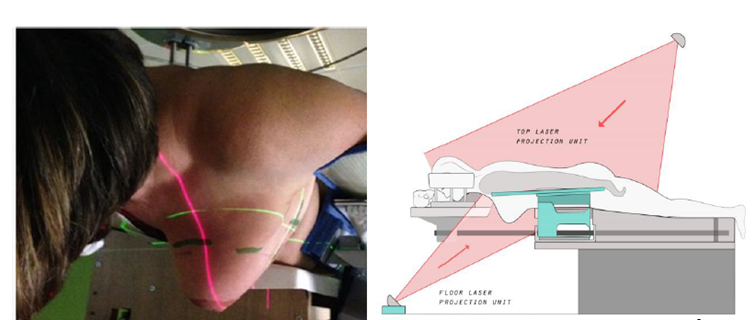
On-site clinical training prone
Supine is the standard treatment at the moment, used by the majority of centers. Prone is used in very few centers, despite its known advantages (see this website resources/publications for more information). Prone radiotherapy is not part of the radiotherapy curriculum, so there is a need to provide education and training for prone radiotherapy. We have developed an on-site training plan, which is implemented in 3 phases: phase 1 Right-sided breast radiotherapy, phase 2 Left-sided breast radiotherapy with deep inspiration breath hold (DIBH), phase 3 Irradiation of breast and lymph nodes right and left side.
The first training phase focused on post-operative irradiation of the right breast without the regional lymph node regions. All patients in this group have advantages of irradiation in the prone position: lower acute toxicity, better medium-term cosmetic results, and lower lung dose.
This initial training phase consists of 4 sessions. During the first session, positioning on the OABC BC4 is taught. Then the CT simulation is performed on newly enrolled patients in a collaboration with the local CT simulation team. The focus of the 2nd session is on the first treatment on the linear accelerator of these patients. Optionally, newly enrolled patients can also be taken into CT simulation. The timing of the 3rd and 4th sessions is agreed with the local team, depending on the need for guidance: CT simulation, linear accelerator or both.
In the second training phase, the focus is on post-operative irradiation of the left breast without the regional lymph node regions. In left-sided radiotherapy, limiting radiation dose to the heart is of great importance. Many centers use a technique of deep inspiration breath hold (DIBH) during irradiation to limit cardiac dose and prevent late cardiac events. Comparative studies between radiation therapy combined with deep inspiration breath hold in the supine or prone position have shown that the combination in the prone position gives the lowest cardiac doses (see this website resources/publications for more info on this). The challenge in the second training phase lies in the application of the local technique of deep inspiration breath hold for patients who are irradiated in the prone position. For this purpose, two local sessions are planned; the first focused on CT simulation; the second focused on treatment with the linear accelerator.
In the third training phase, the focus will be on irradiating the breast and regional lymph node regions in the prone position, which offers the greatest advantages for the patients compared to treatment in the supine position. This training phase will be preceded by preparations using digital consultation in order to focus the local training on the specific choices of the radiotherapy centers regarding radiation directions. We plan 2 local training sessions.
